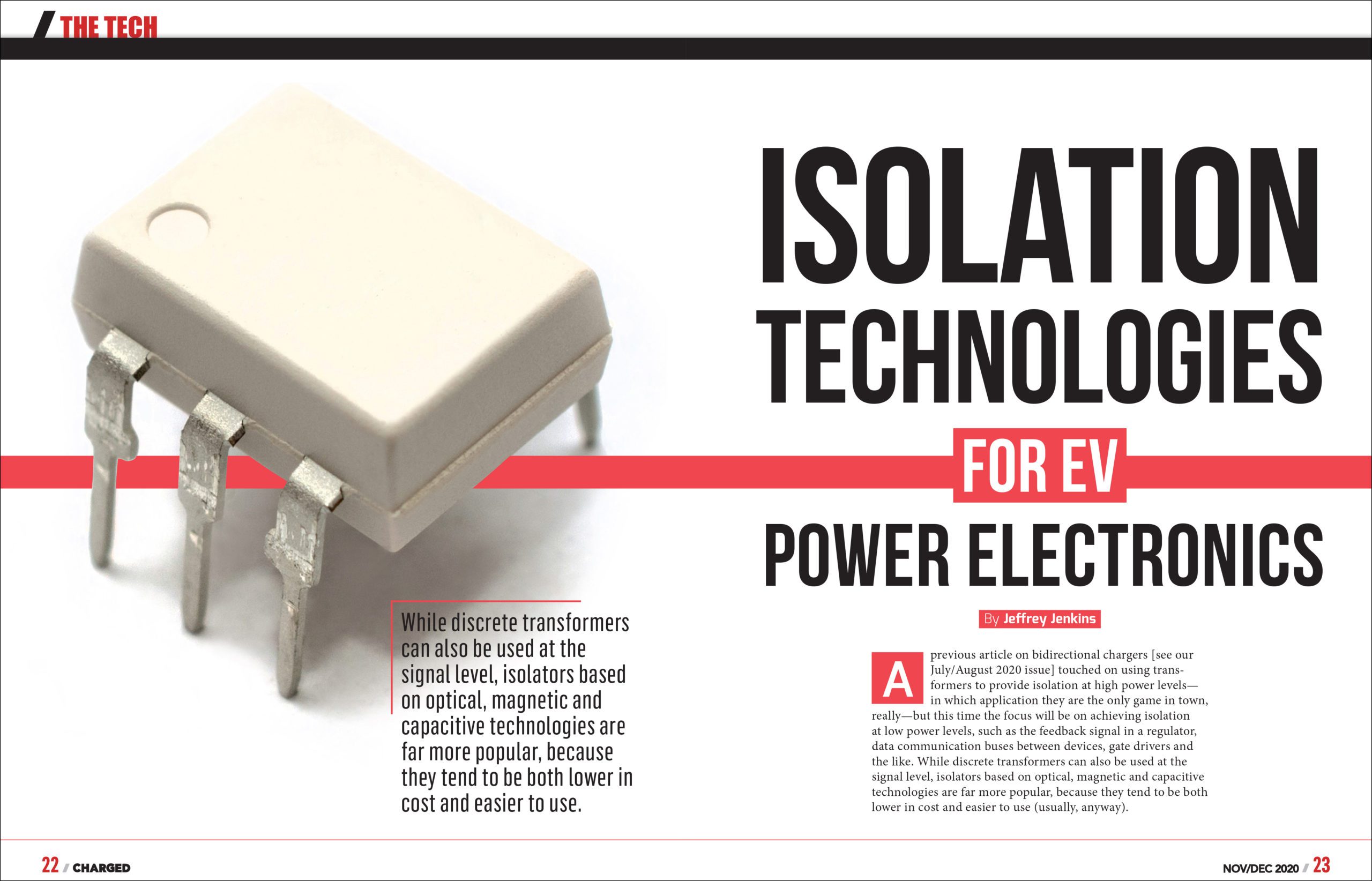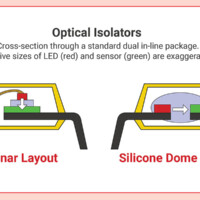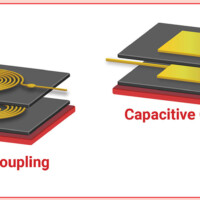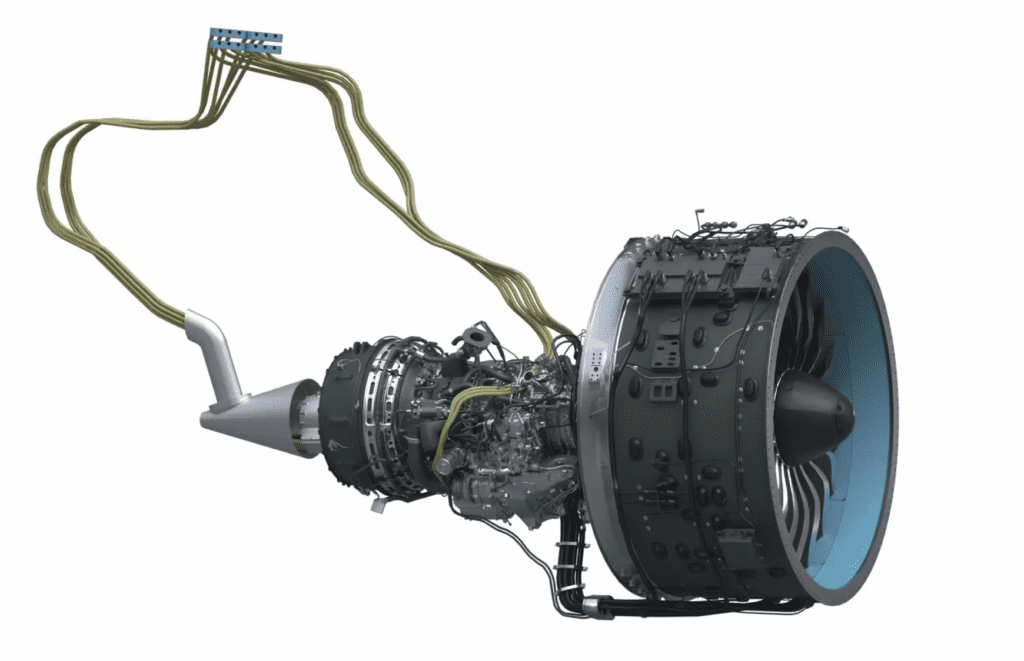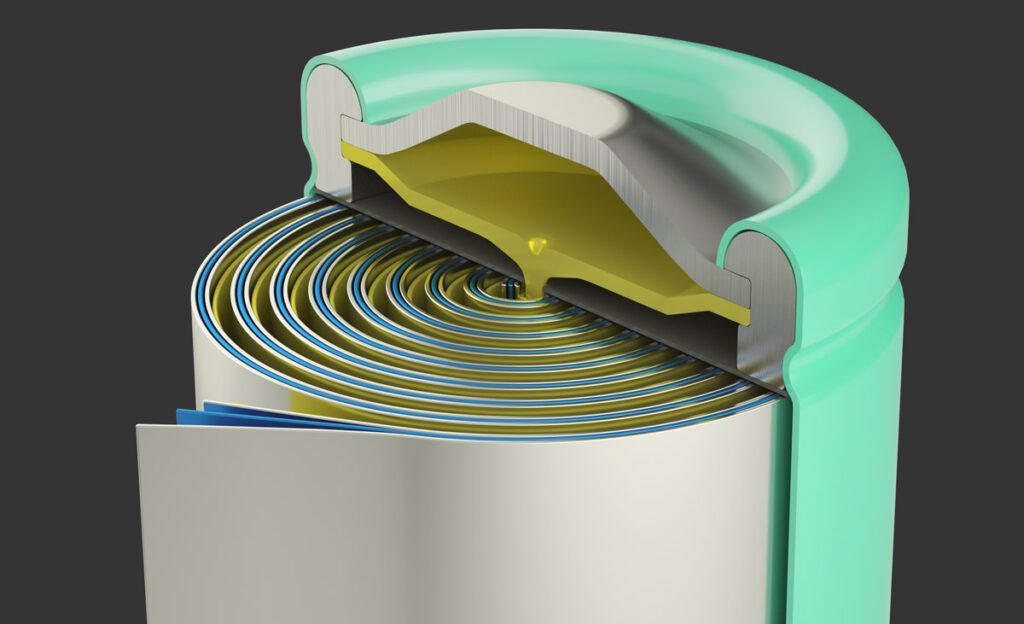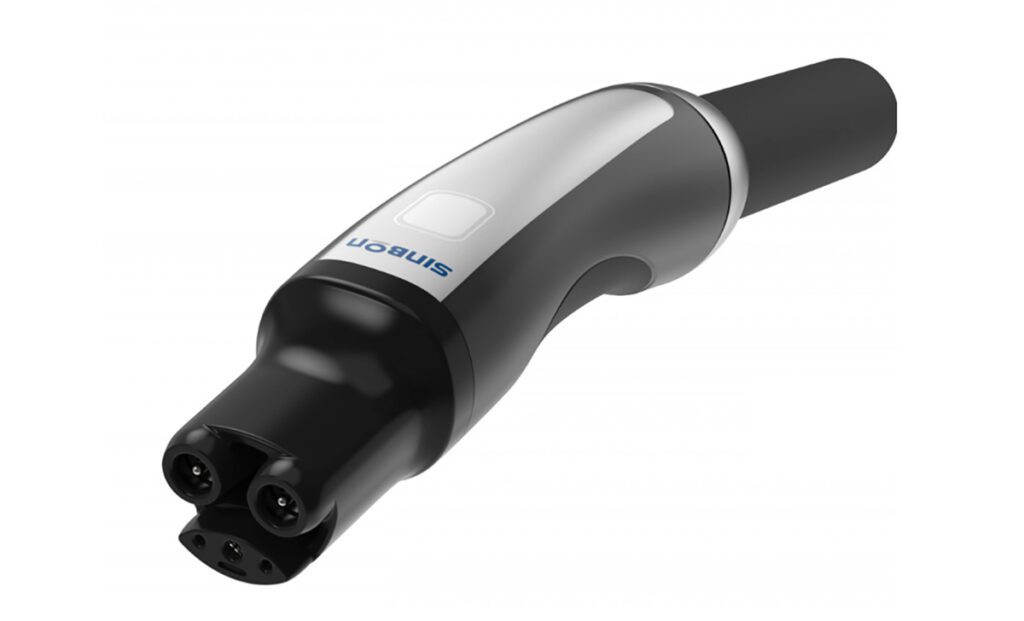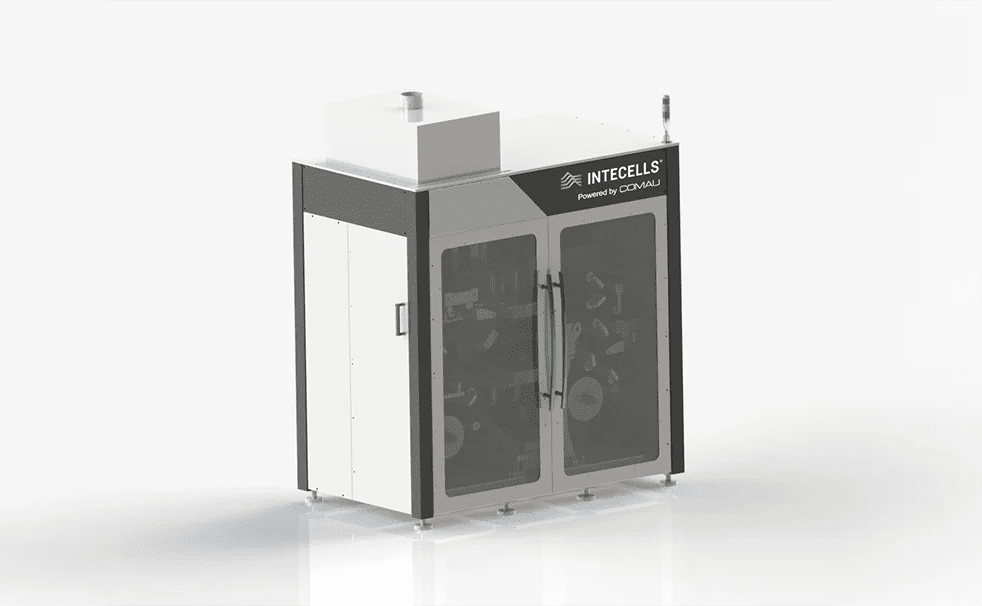A previous article on bidirectional chargers touched on using transformers to provide isolation at high power levels—in which application they are the only game in town, really—but this time the focus will be on achieving isolation at low power levels, such as the feedback signal in a regulator, data communication buses between devices, gate drivers and the like. While discrete transformers can also be used at the signal level, isolators based on optical, magnetic and capacitive technologies are far more popular, because they tend to be both lower in cost and easier to use (usually, anyway).
Of course, the cheapest (though not necessarily the easiest to use) option is not to use an isolator at all, so the first consideration is whether one is even necessary, either for the circuit to operate, for safety, and/or to minimize electrical noise problems. Any power converter for EV applications (charger, inverter, DC/DC converter, etc) that is either supplied by the mains or a >48 V battery pack will pretty much require strict isolation between its power (high-voltage) and control (low-voltage) circuits. In cases where isolation isn’t required for safety reasons, it still might make the circuit more reliable to use it, such as driving the gates of the switches in a totem-pole or bridge circuit. For example, to turn on a MOSFET or IGBT, its gate needs to be made more positive than its source or emitter, respectively, by about 10 V. The lower switches in a half-bridge all have their sources/emitters referred to “ground” (more correctly, the negative rail), which makes it easy to control them directly, and with little worry that noise from rapid voltage swings (i.e. high dV/dt) will be coupled back through them. The sources/emitters in the upper switches, however, do swing violently with each state change, and their potential with respect to the negative rail is undefined when off, and not even fixed when on, since the voltage across the load will vary as well (due to, say, the back EMF of a traction motor changing with RPM). To drive the upper switches requires either an isolator or a level-translating (aka “high-side”) driver IC. The latter IC essentially lets the driver for the high-side gate follow the potential of the source/emitter of the switch being driven while level-translating the control signal up to that same potential. These high-side driver ICs are enormously popular in, shall we say, cost-sensitive power supply applications, because they are much cheaper than any form of isolator and at least appear to be much easier to use. However, because there is no galvanic isolation, the swings in voltage at each transition of the source/emitter can be coupled back through them, wreaking havoc elsewhere, or even leading to an invariably fatal failure mode called “latchup,” in which the polarity of the supply terminals is effectively reversed during the high dV/dt event. An isolated gate driver IC also follows the potential on the source/emitter of the switch it is driving, but with only a small amount of parasitic capacitance to couple dV/dt back through it (and no possibility of inadvertently forward-biasing any substrate diodes, leading to latchup), it can tolerate way higher levels of dV/dt, and can be designed to withstand an almost arbitrarily high voltage as well.
Any power converter for EV applications (charger, inverter, DC/DC converter, etc) that is either supplied by the mains or a >48 V battery pack will pretty much require strict isolation between its power and control circuits.
Another common application in which isolation might not be needed for functionality, but which safety regulations may demand anyway, is the voltage (or current) feedback path in a power supply, charger, etc. If the control circuit is on the primary side of the converter’s isolation transformer, then some means of isolating the feedback signal will be necessary to maintain galvanic isolation between the primary and secondary. In some cases, the control circuit can be placed on the secondary side, however, in which case it will receive the feedback signal directly, and the burden for maintaining galvanic isolation—if necessary—will shift to the drive signals for the primary-side switches. Whether placing the control circuit on the secondary side is even possible depends entirely on how it will receive power to start working in the first place (a classic chicken-and-egg kind of problem, then). In any event—not to point out the obvious—isolation of an analog signal requires either a linear isolator or encoding/decoding of the signal so that a digital isolator can be used. As we’ll discuss next, pretty much all isolators can handle digital signals (i.e. pulses), but only the optical types have ever been used for conveying analog signals (ignoring, for the moment, isolator ICs that have the encoding/decoding circuits built into them).
Another common application in which isolation might not be needed for functionality, but which safety regulations may demand anyway, is the voltage (or current) feedback path in a power supply, charger, etc.
Optical isolators (also known by the unsurprising portmanteau optoisolators) are one of the oldest types (along with transformers) and employ many different approaches. One of the earliest examples literally consisted of an opaque tube with an incandescent lamp at one end and a photoresistive cell (usually based on CdS, or cadmium sulfide) at the other. Bandwidth was in the low single-Hz range, and linearity was terrible too, since neither the lamp nor the photoresistor are all that linear in the first place. The next major iteration replaced the incandescent lamp with an LED, and the CdS cell with a phototransistor (or photodiode), greatly improving bandwidth (a few kHz was now possible), and with better, though not exactly spectacular, linearity. Within a couple of years, it was learned that the brightness of LEDs declines over time, even when supplied by a fixed current, so these miracle light sources that were supposed to last for eternity turned out to have a finite lifespan after all. This is not as big a problem as it might seem, however, since in most applications the optoisolator is either operated digitally (that is, on or off) or else wrapped inside a feedback loop, so that the loss of brightness over time is compensated for automatically (up until the circuit runs out of loop gain or drive current, anyway). I’ve used devices based on this approach (e.g. HCNR200, LOC111, IL300) for monitoring bus voltage, and they work exceptionally well, and as long as the LED isn’t run at too high a current (losing some of the dynamic range) the operational lifespan should be >100,000 hours.
Optical isolators (also known by the unsurprising portmanteau optoisolators) are one of the oldest types (along with transformers) and employ many different approaches.
Still, even a 100,000-hour lifespan only amounts to a bit over 11 years if the product is operated 24/7, so designers sought out alternatives that didn’t rely on LEDs. The two most viable types were capacitive and micromagnetic (chip-scale transformers, basically). Capacitive isolators consist of a pair of capacitors formed by depositing a metal onto either side of a thin insulating layer (usually SiO2—the same as used in CMOS ICs), with one capacitor carrying AC in the forward direction and the other carrying the return current. The insulating layer forms a contiguous barrier which does not rely on an air gap at all (unlike the typical optoisolator), so it can meet stringent safety regulations on creepage and clearance distances within a relatively small package. Since the capacitances involved here are extremely small, signals are usually encoded by either having them modulate the frequency of a much higher-frequency oscillator (i.e. FM) or toggling said oscillator on and off (i.e. burst AM); the former could be used for conveying analog signals, while the latter is strictly for digital applications (including gate drivers). The main downside to capacitive isolators is that they tend to have relatively poor immunity to noise coupled across them as a result of high dV/dt—Common Mode Transient Immunity, or CMTI, is the key spec to look for in the datasheet. Devices intended for gate-driver use will have appropriately high levels of CMTI, but caveat emptor if one tries to use a garden-variety digital capacitive isolator as a gate driver.
Since making the insulator thicker doesn’t really affect the magnetic operation, it’s easier to achieve an almost arbitrarily high voltage withstand rating than it is with the capacitive type.
Isolators based on magnetic coupling consist of tiny spiral coils of metal printed onto either side of an insulator (again, usually SiO2, though polymeric materials are used as well). The magnetic field from one coil induces a current in the other, just like a regular transformer, and since making the insulator thicker doesn’t really affect the operation—just slightly lowering the coupling coefficient with increasing distance between the coils—it’s easier to achieve an almost arbitrarily high voltage withstand rating than it is with the capacitive type. These micro-sized transformers can also be used to provide isolated power to the secondary side circuitry, which is a huge advantage over pretty much every other isolator technology (save using actual gate-drive transformers). Theoretically, magnetic isolators are susceptible to bit-flipping or other erroneous operation from external magnetic fields, but in practice this rarely seems to be an issue, because the coils are so small that they really only respond to very high frequencies. The main downsides to magnetic isolators are that they tend to consume more power for a given data rate than capacitive types (though perhaps not any more than traditional optoisolators) and that they usually cost a lot more than capacitive types because of the more complicated fabrication process (though, again, on par with the cost of equivalent optoisolators).
The last type of isolator to be discussed here is the one mentioned first: a discrete, signal-level transformer. These are constructed much like their higher-power brethren, but with perhaps more emphasis on minimizing the number of turns at the expense of a larger core size (to reduce leakage inductance and stray capacitance). While signal transformers are widely used in data isolators—every Ethernet port on the planet has one, for example—they are also quite popular in gate-drive applications because they convey the power needed to slew the gate directly from the driver circuit itself. Another advantage is that additional switches can be driven by merely adding more secondaries. It would seem, then, that a transformer is the simplest way to drive the gates of any high-side switches, but there are a number of gotchas waiting to trap the unwary. One of the most insidious is that leakage inductance—which arises from the less-than-perfect coupling between windings in a transformer—opposes each change in voltage by creating a small spike and by looking like a high impedance. The latter results in the driver circuit being effectively disconnected from the gate until the leakage inductances are reset, which can lead to spurious operation of the switch, and even short bursts of oscillation (the old and colorful term for such is snivet), both of which can cause the switch to fail (or the product to fail EMC compliance testing). Another downside to transformers is that the forward and reverse volt * seconds must be equal to prevent core saturation. This means that a unipolar signal (such as from 5 V logic) must first be converted to bipolar with an average value of 0 V, and the simplest way to do that is with a coupling capacitor. This approach is best suited for cases in which a rather narrow range of duty cycle needs to be accommodated, which means it isn’t a good choice for motor drives, buck converters, and the like. Otherwise, IC isolators using either capacitive or micromagnetic technology have proven to be superior overall, not only to transformers but to their optical predecessors as well.
Read more EV Tech Explained articles.
This article appeared in Charged Issue 52 – November/December 2020 – Subscribe now.







